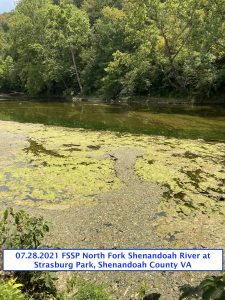Decreasing Water Levels and Algal Blooms Pose Threats to Human Health
FOSR’s 2021 Summer E. coli Results through 07.28.2021
Yesterday, and for the past five weeks, the E. coli levels measured at site FW36, Manassas Run, upstream of the confluence with main-stem Shenandoah River at Morgan’s Ford, just upstream of the public boat landing, have exceeded the previous Virginia water-quality standard threshold of 235 E. coli colony forming units per 100 mL of water sample for primary recreational use.
07.28.2021 FW36 – Manassas Run 648.8 MPN of E. coli colony-forming units per 100 mL.
FOSR 2021 Summer Quantitative E. coli Concentration Results through 07.28.2021
 The very noticeable decreasing water levels and increasing algal blooms in the Shenandoah River watershed pose potential health threats to humans, pets, livestock, and wildlife.
The very noticeable decreasing water levels and increasing algal blooms in the Shenandoah River watershed pose potential health threats to humans, pets, livestock, and wildlife.
VDH’s Prevention Tips for when Harmful Algal Blooms are present –
- Avoid direct contact with water that has an unusual color, odor, or where advisory signs are posted. This means no swimming, wading, paddling, diving, or water-skiing in affected waters.
- If direct contact has been made with water containing cyanobacteria, wash off with fresh water. In some cases, skin irritation will appear after prolonged exposure. If symptoms persist, consult your local health care provider.
- Never drink untreated water. Do not drink water from an area where cyanobacteria have been identified.
- Do not let children, pets, or livestock get into or drink from affected waters.
- People that are prone to respiratory allergies or asthma should avoid areas with cyanobacterial blooms.

- Do not eat the internal organs of fish caught in waters containing cyanobacteria. If you have cleaned fish taken from affected waters, thoroughly wash any of your skin that has come into contact with the fish.
- Use rubber gloves if contact with affected waters must be made.
- VDH Hotline 1-888-238-6154
https://www.vdh.virginia.gov/content/uploads/sites/178/2021/03/VDH-Cyanobacteria-Flyer4_16_21.pdf
The post Decreasing Water Levels and Algal Blooms Pose Threats to Human Health appeared first on FOSR.


